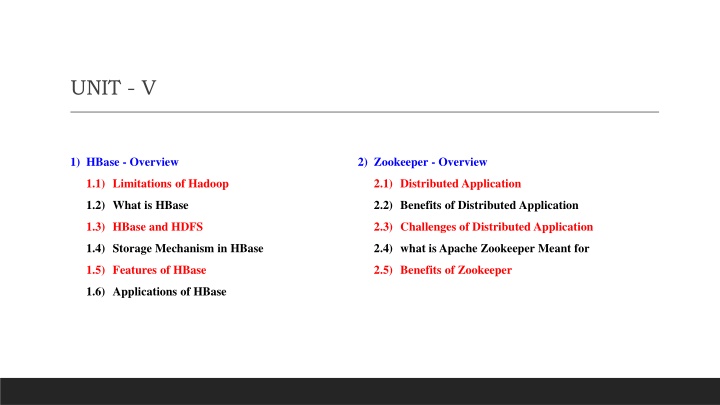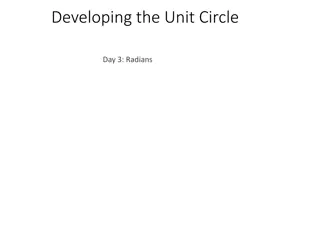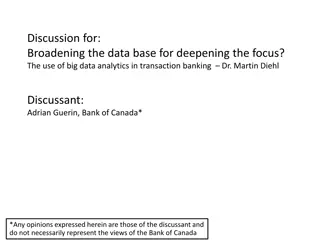
HBase and Zookeeper: Overview, Features, and Applications
"Explore the differences between relational and non-relational databases like HBase, and understand the concept of row and column-oriented data storage. Learn about the benefits, limitations, and challenges of distributed applications using Apache Zookeeper."
Download Presentation

Please find below an Image/Link to download the presentation.
The content on the website is provided AS IS for your information and personal use only. It may not be sold, licensed, or shared on other websites without obtaining consent from the author. If you encounter any issues during the download, it is possible that the publisher has removed the file from their server.
You are allowed to download the files provided on this website for personal or commercial use, subject to the condition that they are used lawfully. All files are the property of their respective owners.
The content on the website is provided AS IS for your information and personal use only. It may not be sold, licensed, or shared on other websites without obtaining consent from the author.
E N D
Presentation Transcript
UNIT - V 1) HBase - Overview 2) Zookeeper - Overview 1.1) Limitations of Hadoop 2.1) Distributed Application 1.2) What is HBase 2.2) Benefits of Distributed Application 1.3) HBase and HDFS 2.3) Challenges of Distributed Application 1.4) Storage Mechanism in HBase 2.4) what is Apache Zookeeper Meant for 1.5) Features of HBase 2.5) Benefits of Zookeeper 1.6) Applications of HBase
1) 1) Hbase Hbase - - Overview Overview HBase is a Non-Relational Database Management System Column-Oriented that runs on top of HDFS
1) 1) Hbase Hbase - - Overview Overview Database are classified into 2 types 1) Relational Database 2) Non Relational Database Relational Database Non Relational Database A relational database stores data in tables composed of rows and A non-relational database is a type of database that doesn t store columns. data in tables but instead in whatever format is best for the type of data being stored. Relational databases are suitable for storing, retrieving, and used to store a mix of structured and unstructured data. manipulating well-defined, structured data. Some of the most common relational databases include: MySQL, Some of the most common non-relational databases IBM Db2, Snowflake, Amazon ,Aurora,,PostgreSQL, Microsoft SQL include: MongoDB, ,IBM Cloundant, Amazon DynamoDB, Apache Server Cassandra , HBase SQL, or Structured Query Language, is the most common Non-relational databases are said to be NoSQL, meaning that they programming language used to interface with relational databases don t use Structured Query Language, even though many NoSQL databases do support SQL queries.
1) 1) Hbase Hbase - - Overview Overview Data store are classified into 2 types 1) Row Oriented Data store or Row Oriented Database 2) Column Oriented store or Column Oriented Database Row Oriented Database Column Oriented Database Row Oriented Databases are Databases that Organize data by Column Oriented Databases are Databases that Organize data by field, record, keeping all of the data associated with a record next to each keeping all of the data associated with a field next to each other in other in memory. memory. In a row store, or row oriented database, the data is stored row In a Column store, or Column oriented database, the data is stored by row, such that the first column of a row will be next to the last field by field column of the previous row. They are Optimized for reading and writing rows effectively They are Optimized for reading and writing Columns effectively If an application needs row wise data for processing, then better to If an application needs Column wise data for processing, then better choose row oriented database like oracle, MySQL etc.. to choose column oriented database like Hbase,Cassandra etc.. Commonly used for OLTP style applications Commonly used for OLAP style applications
1) 1) Hbase Hbase - - Overview Overview Row vs Column Oriented Databases Row Oriented Database 100 Ram 20000 101 Sita 25000 102 Lak 20000 Column Oriented Database 100 101 102 103 Ram Siata Lak Bharath 20000
1) 1) Hbase Hbase - - Overview Overview 1.1) Limitations of Hadoop HDFS HBase 1) HDFS performs Batch Processing 1) HBase performs Real Time Processing Batch Processing : The Collection and Real Time Processing : The Immediate Storage of Data, for processing at a Processing of Data after the transaction scheduled time when a sufficient amount of occurs with the Database being updated at data has been accumulated the time of the event Example : Credit Card Bill Generation Example : Flight Reservation processing 2) HDFS does sequential access of Data 2) Hbase does Random access of Data Means one has to search the entire Means one can access data randomly dataset even for the simplest of Jobs2) 3) HDFS is a File System 3) Hbase is a Database
1) 1) Hbase Hbase - - Overview Overview 1.1) Limitations of Hadoop (or) HBase vs HDFS HDFS HBase 1) HDFS performs Batch Processing 1) HBase performs Real Time Processing Batch Processing : The Collection and Real Time Processing : The Immediate Storage of Data, for processing at a Processing of Data after the transaction scheduled time when a sufficient amount of occurs with the Database being updated at data has been accumulated the time of the event Example : Credit Card Bill Generation Example : Flight Reservation processing 2) HDFS does sequential access of Data 2) Hbase does Random access of Data Means one has to search the entire Means one can access data randomly dataset even for the simplest of Jobs 2)
1) 1) Hbase Hbase - - Overview Overview 1.4) Storage Mechanism of HBase HBase is a column-oriented database and the tables in it are sorted by row. The table schema defines only column families, which are the key value pairs. A table have multiple column families and each column family can have any number of columns. Subsequent column values are stored contiguously on the disk. Each cell value of the table has a timestamp. In short, in an HBase: Table is a collection of rows. Row is a collection of column families. Column family is a collection of columns. Column is a collection of key value pairs.
1) 1) Hbase Hbase - - Overview Overview 1.4) Storage Mechanism of HBase
1) 1) Hbase Hbase - - Overview Overview 1.4) Storage Mechanism of HBase HBase uses a column-oriented storage mechanism, and its architecture is inspired by Google's Bigtable. The storage mechanism is designed to provide high performance, scalability, and fault tolerance. Data in HBase is organized into column families. A column family is a logical grouping of columns, and all the columns within a column family are stored together in an HFile. Each column family can have a different set of columns.
1) 1) Hbase Hbase - - Overview Overview 1.5) Features of HBase HBase is a Column oriented Database which is commonly used for OLAP Applications. Hbase performs Real Time Processing HBase is a Open source Data warehouse component built on top of Hadoop HBase is linearly scalable. It has automatic failure support. It provides consistent read and writes. It integrates with Hadoop, both as a source and a destination. It has easy java API for client. It provides data replication across clusters.
1) 1) Hbase Hbase - - Overview Overview 1.6) Applications of HBase Apache HBase is used to have random, real-time read/write access to Big Data. It hosts very large tables on top of clusters of commodity hardware. Apache HBase is a non-relational database modeled after Google's Bigtable. Bigtable acts up on Google File System, likewise Apache HBase works on top of Hadoop and HDFS. It is used whenever there is a need to write heavy applications. HBase is used whenever we need to provide fast random access to available data. Companies such as Facebook, Twitter, Yahoo, and Adobe use HBase internally.
2) ZOOKEEPER 2) ZOOKEEPER WHAT IS ZOOKEEPER ZooKeeper is a distributed co-ordination service to manage large set of hosts. Co-ordinating and managing a service in a distributed environment is a complicated process. ZooKeeper solves this issue with its simple architecture and API. ZooKeeper allows developers to focus on core application logic without worrying about the distributed nature of the application. The ZooKeeper framework was originally built at Yahoo! for accessing their applications in an easy and robust manner. Later, Apache ZooKeeper became a standard for organized service used by Hadoop, HBase, and other distributed frameworks. For example, Apache HBase uses ZooKeeper to track the status of distributed data.
2) ZOOKEEPER 2) ZOOKEEPER 2.1) DISTRIBUTED APPLICATIONS A distributed application can run on multiple systems in a network at a given time (simultaneously) by coordinating among themselves to complete a particular task in a fast and efficient manner. Normally, complex and time-consuming tasks, which will take hours to complete by a non-distributed application (running in a single system) can be done in minutes by a distributed application by using computing capabilities of all the system involved The time to complete the task can be further reduced by configuring the distributed application to run on more systems. A group of systems in which a distributed application is running is called a Cluster and each machine running in a cluster is called a Node. A distributed application has two parts, Server and Client application. Server applications are actually distributed and have a common interface so that clients can connect to any server in the cluster and get the same result. Client applications are the tools to interact with a distributed application
2) ZOOKEEPER 2) ZOOKEEPER 2.1) DISTRIBUTED APPLICATIONS
2) ZOOKEEPER 2) ZOOKEEPER 2.2) Benefits of Distributed Applications Benefits of DistributeApplications Reliability Failure of a single or a few systems does not make the whole system to fail. Scalability Performance can be increased as and when needed by adding more machines with minor change in the configuration of the application with no downtime. Transparency Hides the complexity of the system and shows itself as a single entity / application. 2.3) Challenges of Distributed Applications Challenges of Distributed Applications Race condition Two or more machines trying to perform a particular task, which actually needs to be done only by a single machine at any given time. For example, shared resources should only be modified by a single machine at any given time. Deadlock Two or more operations waiting for each other to complete indefinitely. Inconsistency Partial failure of data.
2) ZOOKEEPER 2) ZOOKEEPER 2.2) Benefits of Distributed Applications Benefits of DistributeApplications Reliability Failure of a single or a few systems does not make the whole system to fail. Scalability Performance can be increased as and when needed by adding more machines with minor change in the configuration of the application with no downtime. Transparency Hides the complexity of the system and shows itself as a single entity / application. 2.3) Challenges of Distributed Applications Challenges of Distributed Applications Race condition Two or more machines trying to perform a particular task, which actually needs to be done only by a single machine at any given time. For example, shared resources should only be modified by a single machine at any given time. Deadlock Two or more operations waiting for each other to complete indefinitely. Inconsistency Partial failure of data.
2) ZOOKEEPER 2) ZOOKEEPER 2.4) What is Apache ZooKeeper Meant For? Apache ZooKeeper is a service used by a cluster (group of nodes) to coordinate between themselves and maintain shared data with robust synchronization techniques. ZooKeeper is itself a distributed application providing services for writing a distributed application. The common services provided by ZooKeeper are as follows Naming service Identifying the nodes in a cluster by name. It is similar to DNS, but for nodes. Configuration management Latest and up-to-date configuration information of the system for a joining node. Cluster management Joining / leaving of a node in a cluster and node status at real time. Leader election Electing a node as leader for coordination purpose. Locking and synchronization service Locking the data while modifying it. This mechanism helps you in automatic fail recovery while connecting other distributed applications like Apache HBase. Highly reliable data registry Availability of data even when one or a few nodes are down.
2) ZOOKEEPER 2) ZOOKEEPER 2.4) What is Apache ZooKeeper Meant For? Distributed applications offer a lot of benefits, but they throw a few complex and hard-to-crack challenges as well. ZooKeeper framework provides a complete mechanism to overcome all the challenges. Race condition and deadlock are handled using fail-safe synchronization approach. Another main drawback is inconsistency of data, which ZooKeeper resolves with atomicity.
2) ZOOKEEPER 2) ZOOKEEPER 2.5) Benefits of ZooKeeper Here are the benefits of using ZooKeeper Simple distributed coordination process Synchronization Mutual exclusion and co-operation between server processes. This process helps in Apache HBase for configuration management. Ordered Messages Serialization Encode the data according to specific rules. Ensure your application runs consistently. This approach can be used in MapReduce to coordinate queue to execute running threads. Reliability Atomicity Data transfer either succeed or fail completely, but no transaction is partial.






















